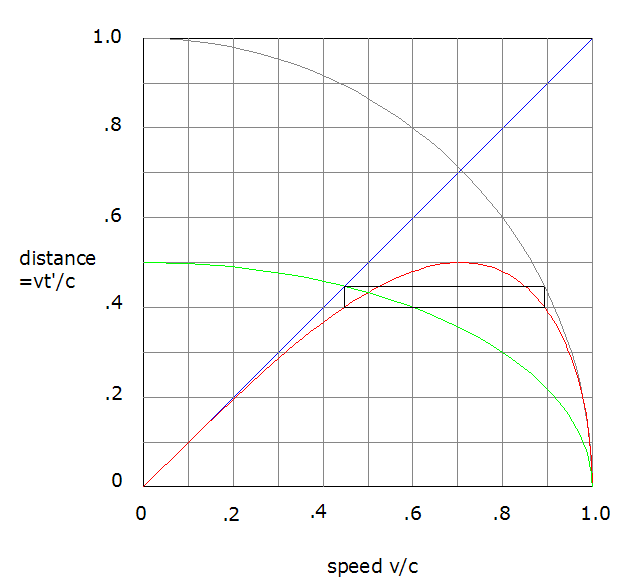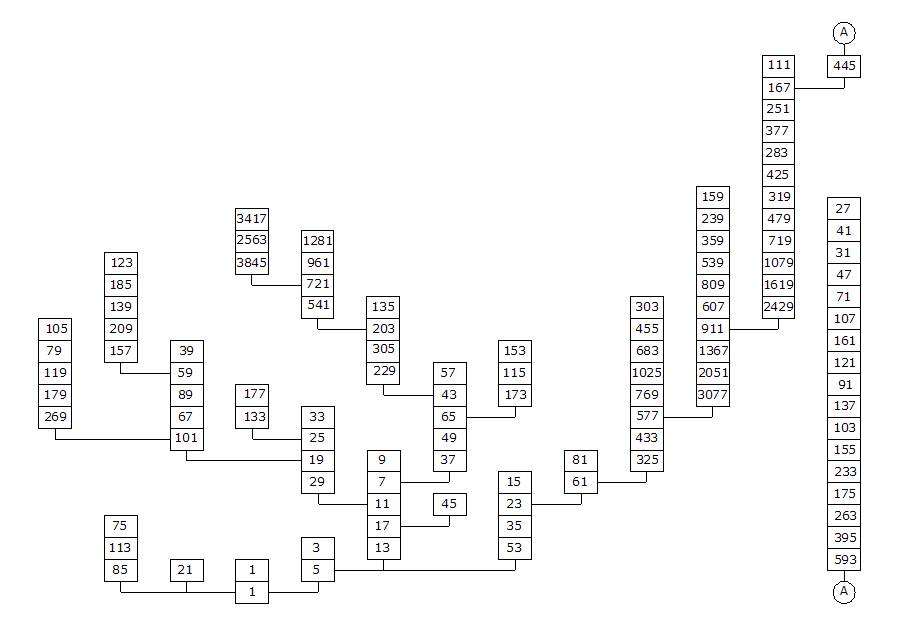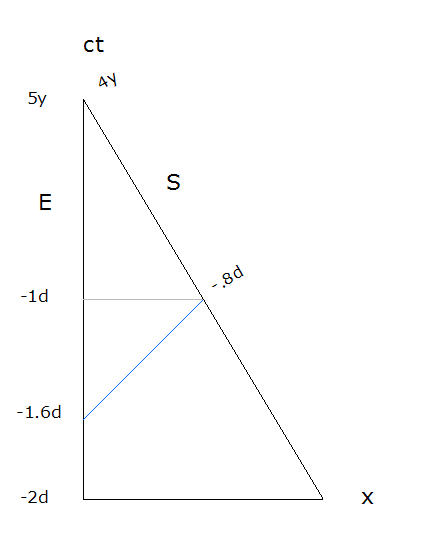

phyti
Senior Members-
Posts
212 -
Joined
-
Last visited
Content Type
Profiles
Forums
Events
Everything posted by phyti
-
[Ships moving past your ship at various speeds don't alter your equipment. Their speed does alter their measurements. It's the same as moving observers assigning different x and t coordinates for the same event, based on their relative speed.] md65536; [Yes]
-
md65536; An anaut Al, leaves Earth for a target object Q 12 ly distant by an earth star chart. Al's flight plan is to orbit Earth at a large distance until his ship reaches .3c. From reading his 'relativity' manual, he knows he has two options. 1. remain an anaut moving at .3c, or 2. assume a pseudo rest frame, with Q approaching him at .3c. If 1, he arrives at 38 yr, knowing he and his ship have lost 2 yr due to time dilation. If 2, Q arrives at 38 yr. He knows that a clock at rest does not lose time. His watch and computer both agree with the onboard clock. He can verify the speed of Q using light signals. The only other variable is distance. He concludes the universe has apparently contracted in the direction of motion, to explain the time difference, i.e. a mental reconciliation, without any physical processes. No.1 is believable since SR predicts on the basis of physical processes, fast moving clocks run slower. No.2 is absurd, since a fast moving space craft cannot influence distant parts of the universe, but it can influence the perception of an occupant. When this is accepted, there is no need for no.2. When an observer measures lc of objects, he does not conclude lc of the space between objects. This also points to the anaut's conclusion in no.2 as perception, not corresponding to anything physically real. _________________________ Your puzzle would imply you accept time dilation as a physical phenomenon. When the anaut twin returns to the earth younger than the other, isn't that proof that the anaut twin biological processes occurred at a reduced rate, even though the anaut was not aware? That's the implication of postulate 1, 'physics is the same for all inertial frames', thus the observer cannot detect any differences. Being 'aware' contradicts postulate 1. SR does not say you can't determine the how and why of td and lc. ________________________ Inanimate muons need someone to speak for them.
-
When the atomic clock returns to earth and is compared to the ground based clock, there is a real measurable difference in readings. How can that be if the time dilation isn't real? The length contraction of the atmosphere is the human interpretation of the muon time dilation, to explain the early arrival of the ground. It's a form of reciprocity.
-
Why should time have a direction if it's a scalar? A clock accumulates 'time'. A complete clock has registers for sec, min, hrs, etc, like an odometer. In practice the larger units day, month, yr. etc, are posted as a calendar, but still a record. So where's the direction? It's 3:21 pm, 9-6-2019, which way do I go?
-
md65536; When high altitude high speed muons show their decay times extended, allowing more to reach the ground, is the decay process really slowing or are the scientists imagining it? In the H-K experiment, precision clocks were flown around the world, in both directions. The SR and GR effects of timekeeping were revealed when compared to ground base clocks, though they weren't aware of them while in the air. You may not like the idea of 'things happening without your awareness', but that's the essence of relativity. Mental activity is chemistry, which is EM activity. It was unthinkable before then, that motion can alter perception and measurement. NIST, who's business is time standards, will tell you all clocks drift. GPS will not work without constant periodic adjustments. The world is not the 'ideal' setting people imagine/want it to be.
-
md65536; In the graphic, the arc of radius 1 represents one unit of ct (sec, yr., etc). The red curve is the perception of distance traveled by the observer based on his speed and local time In the interesting scenario of an anaut moving outward from the center of a spherical system of objects, over a range of speeds, the sphere has a maximum radius at v/c=.707c, and two different speeds for each calculated distance. Relative to your puzzle, the green curve is 1/2 the local time for any given speed. Any pair satisfies 'equal distance'. Only one satisfies the '2:1 aging'. A horizontal line between the intersection of the green line and blue diagonal (light speed) projected downward to the red should provide the answer. A speed is .4472 and B speed is .8944. What do you think?
-
md65536; In the 1905 paper, clock B moved away at constant speed from clock A and returned, with clock B recording less time than clock A, even though they were synchronized initially. The thought experiment was done in an SR environment. Two clocks A and B are sent away from location U, in the direction x, at constant speeds a and b respectively. They reverse direction in zero time simultaneously relative to U and return at constant speeds a and b respectively. Each clock does not experience acceleration for the entire trip. This is irrelevant in SR, since gamma (Lorentz factor) only contains 1st order terms v/c, and nothing for acceleration. For political correctness, two clocks can be used, one outbound and one inbound, exchanging data at reversal.
-
What about length contraction? A similar case. The anaut measures his 20 m capsule interior, lc to 90%, with his 1 m tape, lc to 90%, and gets 20 m.
-
There is nothing in my response that implies a moving object causes a distant clock to run slower. An observer A perceives a moving clock B run slower, which results from the B clock's motion.
-
...when in relative motion to an observer. I.e. slow clocks are perceived by others. Local time always appears normal, since the clock owner is affected by time dilation to the same extent as his clock. It's physics, not relativity enforcement by decree.
-
Can't agree. The constant independent speed of light is the reason why EM processes run slower when in relative motion to an observer. A clock is just a periodic process, serving as a measuring tool for human activity. The light clock is simplicity and precision. When the clock is in motion, the light has to chase moving mirrors, for all modes of oscillation. Why doesn't the observer moving with his clock notice, his biological clock is also running slower. A simple analogy is the hunter who aims ahead of the target, to compensate for the target motion.
-
This is the file. Collatz 2018.pdf
-
Most forums are rehashing the same stuff, which gets boring. Went back to a few projects started a dozen yrs ago. This is one of them. The graphic is an incomplete 'tree'. Vixra postings don't provide any constructive feedback! The PDF file is here
-
-
Infinity is not a number!
-
studiot; Einstein papers are available here After introducing the magnet-wire example, Einstein states; "Examples of this sort, together with the unsuccessful attempts to discover any motion of the earth relatively to the ``light medium,'' suggest that the phenomena of electrodynamics as well as of mechanics possess no properties corresponding to the idea of absolute rest. They suggest rather that, as has already been shown to the first order of small quantities, the same laws of electrodynamics and optics will be valid for all frames of reference for which the equations of mechanics hold good. We will raise this conjecture (the purport of which will hereafter be called the ``Principle of Relativity'') to the status of a postulate, and also introduce another postulate, which is only apparently irreconcilable with the former, namely, that light is always propagated in empty space with a definite velocity c which is independent of the state of motion of the emitting body." The 'principle of relativity' is the core idea, light propagation is secondary. The underlined statement refers to an absolute value for light speed being 'out of place' with the 'principle'. Einstein continues; "The introduction of a ``luminiferous ether'' will prove to be superfluous inasmuch as the view here to be developed will not require an ``absolutely stationary space'' provided with special properties, nor assign a velocity-vector to a point of the empty space in which electromagnetic processes take place." Before the 1600's, light speed was thought to be instantaneous. The wave theory and particle theory kept exchanging places for the preferred theory until the evidence accumulated in favor of the discrete quanta of energy. Planck defined it to calculate 'black body' radiation. Einstein used it in his paper on the 'photoelectric effect'. Evidence for light speed being independent of the emitter was verified from many varied sources. This paper specifically shows acceleration is not a causal factor in time dilation, but a means to an end, being to increse speed. https://app.box.com/s/1vw14m394hdcqhjv861b9s246w3gp0lk
-
Light propagation ls a specific instance of a physical process, and would be included in the 1st postulate. A reference frame is a location common to a set of measurements. An anaut in space, with a clock and laser qualifies as a frame of reference.
-
Estranged; The motivation and basis for Special Relativity. In reading the original 1905 paper 'On the Electrodynamics of Moving Bodies', Einstein questions the need for an absolute rest frame, since the same electromagnetic phenomenon occurs whether the magnet moves past a coil, or the coil moves past the magnet, i.e. requiring only relative motion. He was also aware of the failed attempt in the 1880's to detect an absolute motion of the earth relative to a theoretical 'ether', a medium for light propagation. He then forms his theory extending his principle of relativity to all physical phenomena, in the form of the first postulate, 'the laws of physics are the same for all inertial (moving at constant speed) frames of reference '. Then he adds a second postulate, 'the propagation speed of light is constant and independent of the emitter for all inertial frames'. In the development of the coordinate transformations required to compare data from two observers with relative motion, time and space measurements differ. The theory predicts time dilation and length contraction. The idea that motion could alter perception and measurement was totally unexpected, in a world that believed in a universal time and rigid bodies. The mental connection to 'time'. Subjective time requires memory, which allows a comparison of a current state to a previous state for any changes, which lends itself to an interpretation of 'time' flowing. Patients with brain damage to specific areas involved in maintaining a personal chronology, lose their ability to estimate elapsed time, short or long term. Consider the fact that people waking from a comatose state, have no memory of how much elapsed time, whether hrs, days, or even years. If you are in a cave with no light and no clock, how do you know how much 'time' has elapsed? You rely on your memory and sensory input. Since you can't see any of your surroundings, you rely on your biological perception concluding you are still self aware, breathing, pulse, etc. This requires energy, so there is (must be) energy , if there is awareness. The mind supplies the perception of continuity of events just as it supplies the perception of motion for viewing a fast sequence of still images, movies and electronic screens. Any uniform periodic event can serve as a clock to meter/measure 'time' just as a stick with uniform marks serves to measure distance. It provides a means of correspondence of an event of interest to a clock event for future reference. Time like distance is an intangible relation that is malleable in the process of motion. Like the planetary orbits, the lunar sphere, lines, points, etc., these things only exist in the mind. They are real as mental constructs, but there is nothing corresponding to them in the physical world outside the mind. Biological processes are chemical processes, and chemistry is the physical processes of electron clouds surrounding atoms, which involves em (light) interactions. If motion slows the process in a light clock, it will slow the light processes in chemistry.
-
Einstein began with 3 spatial dimensions xr and 1 time dimension. He believed the nature of time was different than that of space. For him the invariant interval was the spatial interval between events, since events don't move. The expression was x12 +x22 +x32 = c2t2 Minkowski wanted to generalize this to a 4D expression, since all the terms are distances. Using complex notation, with x4 = ict, the 4D expression is x12 +x22 +x32 + x42 = s2 Interestingly, distance to an object moving at constant speed is linear only for 1-dimensional head-on motion, and hyperbolic for all other paths with an offset, 2D. Light transit times vary accordingly. I.e., not originating from of Relativity.
-

Is there a simpler way to solve this problem?
phyti replied to John Salerno's topic in Applied Mathematics
For clarity, I would prefer the events defined with the corresponding ratios. a=ace, b=not ace, a=4, b=36, e(x)=number of events (x) e(aa)=4*3=12 e(ab)=4*36=144 e(ba)=36*4=144 e(bb)=36*35=1260 total events=1560 p(ab or ba)=288/1560=12/65=.185 -
4D is a model representing/corresponding to physical behavior. Can you interpret SR in terms of basic physics, matter, light, and motion?
-
No! Obviously I was looking through the wrong end of the telescope.
-
forum1.pdf It's correct.
-
There is a device called an integrator, with a wheel that follows a curve and totals the incremental lengths. A clock performs the same function. It accumulates time along any spacetime curve. It can't move any slower than zero, thus there is no opportunity to gain time. In the 'twin' scenario, the clock that loses the lesser amount of time belongs to the younger twin. For distance, x=vt. For time, t=x/v, Inversely proportional to v. Given x, the greater the speed, the LESS the time (without relativity). It should be no surprise that time is less for high velocities in SR.
-
There is, it's called a clock.



